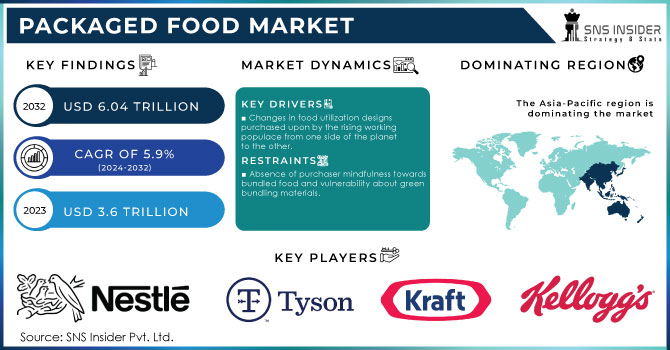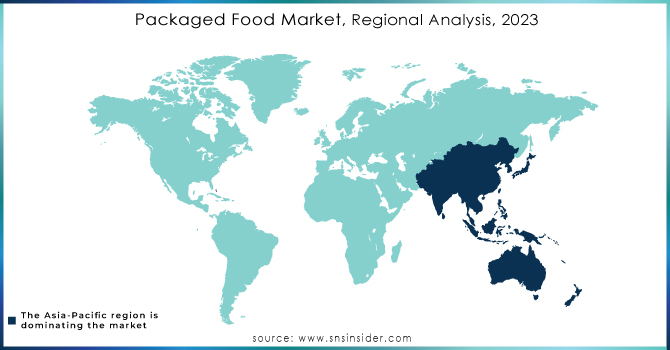Packaged Food Market Report Scope & Overview:

Get More Information on Packaged Food Market - Request Sample Report
The Packaged Food Market Size was esteemed at USD 3.6 trillion out of 2023 and is supposed to arrive at USD 6.04 trillion by 2032, and develop at a CAGR of 5.9% over the forecast period 2024-2032.
Bundled food can be characterized as a foodstuff that has been arranged early and bundled such that builds its timeframe of realistic usability. Most bundled food is viewed as accommodation things and is economically delivered and made accessible for individuals to devour. The idea of bundled food emerged because of contemplations like the simplicity of readiness, utilization, dealing with, and assurance against outer altering. Bundled food sources are easy to deal with, get ready, and eat. They are acquiring fame in both created and agricultural nations since they are very helpful for city tenants.
Bundled food is remembered for the class of items that are bought by buyers habitually. Consequently, the interest in such items stays steady among purchasers. The flare-up of the novel Covid has fundamentally impacted the development of the market around the world. There has been a slight diminish in deals of bundled food items because of the disturbance of the production network and a decrease in the out-of-home utilization of food during the COVID-19 pandemic.
With the new technique, Kraft Heinz is chipping away at less - however greater - developments. The organization has been laying the foundation for new advancements to stick, further developing showcasing, inventory network, and deals execution, Abrams-Rivera said at the virtual gathering. He gave no particular insights concerning projects right now ready to go.
Market Dynamics:
Driving Factors:
-
Developments in handling strategies for broadening the period of usability of food items.
-
Changes in food utilization designs purchased upon by the rising working populace from one side of the planet to the other.
Restraining Factors:
-
Absence of purchaser mindfulness towards bundled food and vulnerability about green bundling materials.
-
Absence of appropriate production network and refrigeration in retail outlets and homes.
Opportunities:
-
Improvement in the retail framework.
-
The developing simplicity of getting foodstuff joined with choices of free home conveyance and different special offers.
Challenges:
-
Absence of profoundly computerized and high-level bundling machines.
-
Natural variables.
Impact of COVID-19:
The COVID-19 pandemic antagonistically impacted the development of the bundled food market. With legislatures forcing lockdowns and severe social separating guidelines, producing offices had to close down, for a brief time or forever. This impacted the interest in bundled food items and harmed the general market. Nonetheless, with the accessibility of antibodies and a decrease in cases, it is guessed that item requests will rise in the future and assist with filling the development in the bundled food market. A portion of the ordinarily bought bundled food items incorporates sauce and toppings and plunges.
Market Estimations:
By Type:
Contingent upon the worldwide bundled food market examination by type, the meat poultry, and fish section represented the most elevated share. The meat poultry and fish portion are developing complex because of the developing utilization of protein-rich food items inferable from it being thought of as sound. Besides, developing reliance on helpfully bundled meat because of expanded partiality of individuals towards comfort drives the market development for this fragment. In terms of product type, the primary categories of the markets are: non-alcoholic beverages such as juices, bottled water, and soft drinks; dairy products including milk, yogurt, and cheese; confectionery including chocolates, candies, and the like; ready meals, snacks, and breakfast cereals to accommodate the busy urban lifestyle; and others. Every segment addresses various consumer needs and trends, striking a balance between necessity and indulgence. Non-alcoholic beverages are included for health concerns and ease of consuming liquid, whereas dairy is required for nutrition and has certain trends, such as probiotic food. Confectionery products and snacks are present for the demand for sweets and savory items and meals are convenient for the fast pace of urbane life. Breakfast cereals are included for a quick and wholesome meal and others or speciality food involves various segments of sauce, spreads, and baby food, among others. Taking these essential segments into account, it is possible to offer a comprehensive marketplace. This typology, in turn, can help to ensure that there always will be a demand for specific products, meaning that new types of products may also emerge and meet the new demand.
Sales Channel:
Contingent upon the worldwide bundled food market gauge by deals channel, the hypermarkets/stores section represented the most noteworthy offer. The development in the hypermarkets/general stores in the bundled food market can be credited to the way that these retail format(s) offer a wide assortment of items and frequently concoct various offers that assist with expanding footfall, subsequently, expanding likely deals of products. The distribution of goods, in turn, is handled primarily by hypermarkets/supermarkets. Department stores also play a significant role, although they provide a smaller range of goods. Convenience stores cater to impulse sales and the need for a quick purchase. An online retail store is becoming an increasingly popular option as it makes shopping even easier. Other segments include specialty stores and warehouse clubs. Both the primary and secondary categories offer a dynamic marketplace. Such dynamics help to ensure the growth with the help of a wide variety of product types and rapidly changing distribution modes.
Regional Analysis: The Asia Pacific is supposed to be the predominant area in the bundled food market before long attributable to the presence of driving players in nations like India and China. North America is supposed to give worthwhile learning experiences to the worldwide bundled food market attributable to the expanded utilization of bundled food items among various populace areas in nations like the U.S and Canada. Europe is expected to observe significant development in the bundled food market because of broad innovative work endeavors to deliver the worked-on nature of items in nations like UK and Germany.

Need Any Customization Research On Packaged Food Market - Inquiry Now
Key Players:
Nestle S.A, Tyson Foods, Kraft Foods Group Inc., General Mills, ConAgra Foods Inc., Smithfield Foods Inc., Kelloggs, JBS S.A, Hormel Foods Corporation, Maple Leaf Foods Inc.
| Report Attributes | Details |
|---|---|
| Market Size in 2023 | US$ 3.6 Trillion |
| Market Size by 2032 | US$ 6.04 Trillion |
| CAGR | CAGR 5.9% From 2024 to 2032 |
| Base Year | 2022 |
| Forecast Period | 2024-2032 |
| Historical Data | 2020-2022 |
| Report Scope & Coverage | Market Size, Segments Analysis, Competitive Landscape, Regional Analysis, DROC & SWOT Analysis, Forecast Outlook |
| Key Segments | • by Type (Dairy Products, Confectionery, Packaged Produce, Bakery & Snacks, Meat, Poultry & Seafood, Ready Meals, and Others) • by Sales Channel (Supermarket/Hypermarket, Specialty Stores, Grocery Stores, Online Stores, and Others) |
| Regional Analysis/Coverage | North America (US, Canada, Mexico), Europe (Eastern Europe [Poland, Romania, Hungary, Turkey, Rest of Eastern Europe] Western Europe [Germany, France, UK, Italy, Spain, Netherlands, Switzerland, Austria, Rest of Western Europe]), Asia Pacific (China, India, Japan, South Korea, Vietnam, Singapore, Australia, Rest of Asia Pacific), Middle East & Africa (Middle East [UAE, Egypt, Saudi Arabia, Qatar, Rest of Middle East], Africa [Nigeria, South Africa, Rest of Africa], Latin America (Brazil, Argentina, Colombia, Rest of Latin America) |
| Company Profiles | Nestle S.A, Tyson Foods, Kraft Foods Group Inc., General Mills, ConAgra Foods Inc., Smithfield Foods Inc., Kelloggs, JBS S.A, Hormel Foods Corporation, Maple Leaf Foods Inc. |
| Drivers | • Developments in handling strategies for broadening the period of usability of food items. • Changes in food utilization designs purchased upon by the rising working populace from one side of the planet to the other. |
| Market Challenges: | • Absence of profoundly computerized and high-level bundling machines. • Natural variables. |

